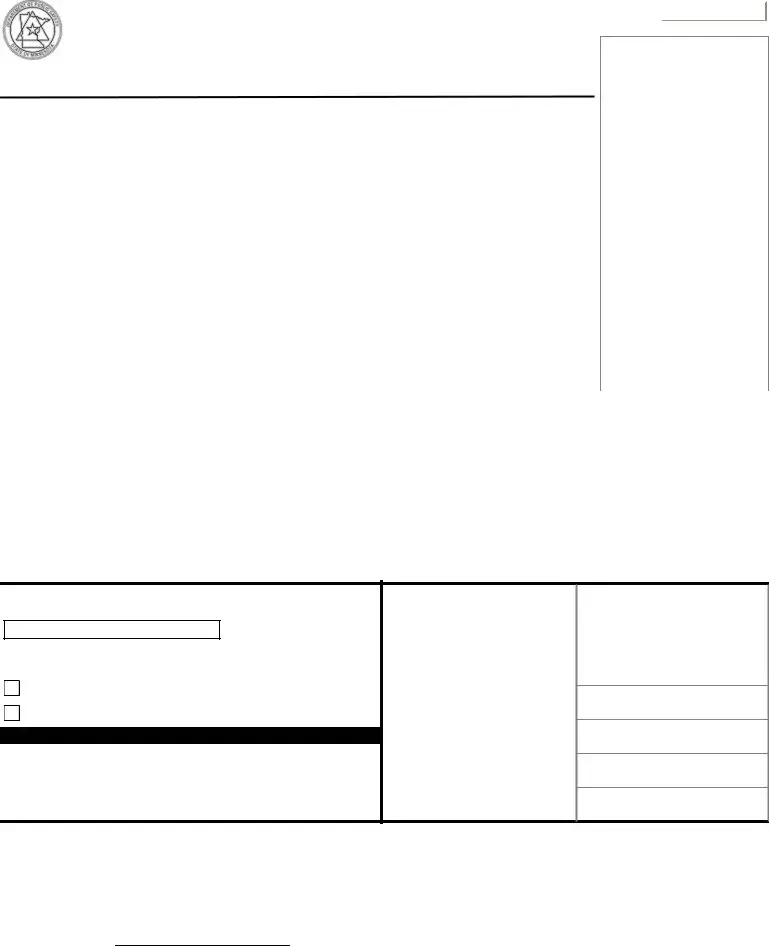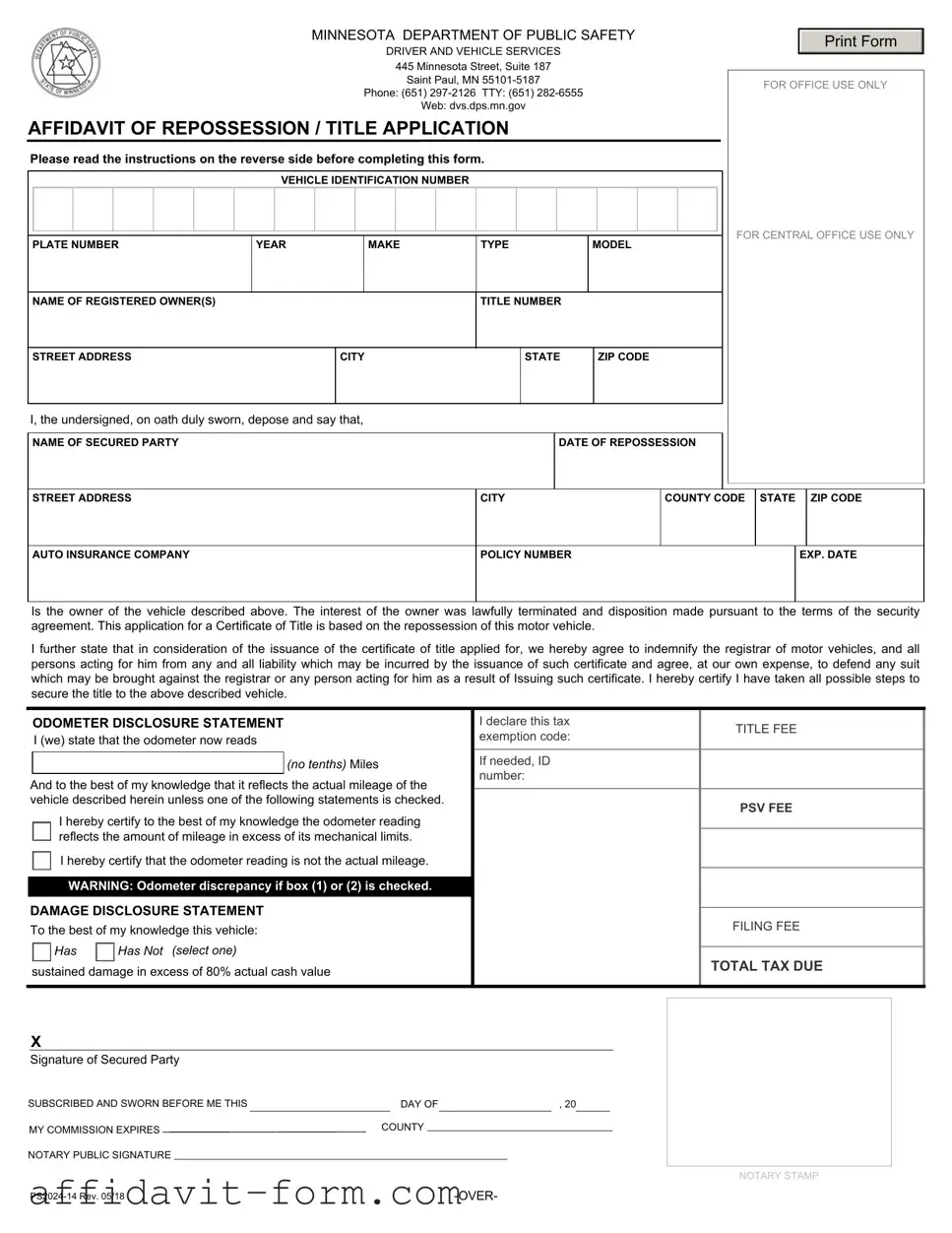
|
MINNESOTA DEPARTMENT OF PUBLIC SAFETY |
|
|
Print Form |
|
DRIVER AND VEHICLE SERVICES |
|
|
445 Minnesota Street, Suite 187
Saint Paul, MN 55101-5187FOR OFFICE USE ONLY Phone: (651) 297-2126 TTY: (651) 282-6555
Web: dvs.dps.mn.gov
AFFIDAVIT OF REPOSSESSION / TITLE APPLICATION
Please read the instructions on the reverse side before completing this form.
|
|
|
|
|
|
|
|
VEHICLE IDENTIFICATION NUMBER |
|
|
|
|
|
|
|
|
|
|
|
|
|
|
|
|
|
|
|
|
|
|
|
|
|
|
|
|
|
|
|
|
|
|
|
|
FOR CENTRAL OFFICE USE ONLY |
|
|
|
|
|
|
|
|
|
|
|
|
|
|
|
|
|
|
|
|
|
|
|
|
|
PLATE NUMBER |
YEAR |
|
|
MAKE |
TYPE |
MODEL |
|
|
|
|
|
|
|
|
|
|
|
|
|
|
|
|
|
|
|
|
|
|
|
|
|
|
|
|
|
NAME OF REGISTERED OWNER(S) |
|
|
|
|
|
|
|
|
TITLE NUMBER |
|
|
|
|
|
|
|
|
|
|
|
|
|
|
|
|
|
|
|
|
|
|
|
|
|
|
|
|
|
|
|
|
|
STREET ADDRESS |
|
|
|
CITY |
|
|
STATE |
|
|
ZIP CODE |
|
|
|
|
|
|
|
|
|
|
|
|
|
|
|
|
|
|
|
|
|
|
|
|
|
|
|
I, the undersigned, on oath duly sworn, depose and say that, |
|
|
|
|
|
|
|
|
|
|
|
|
|
|
NAME OF SECURED PARTY |
|
DATE OF REPOSSESSION |
|
|
|
|
|
|
|
|
|
|
|
|
|
|
|
|
|
|
|
|
|
STREET ADDRESS |
CITY |
COUNTY CODE |
STATE |
ZIP CODE |
|
|
|
|
|
|
|
|
|
AUTO INSURANCE COMPANY |
POLICY NUMBER |
|
|
|
|
EXP. DATE |
|
|
|
|
|
|
|
|
|
Is the owner of the vehicle described above. The interest of the owner was lawfully terminated and disposition made pursuant to the terms of the security agreement. This application for a Certificate of Title is based on the repossession of this motor vehicle.
I further state that in consideration of the issuance of the certificate of title applied for, we hereby agree to indemnify the registrar of motor vehicles, and all persons acting for him from any and all liability which may be incurred by the issuance of such certificate and agree, at our own expense, to defend any suit which may be brought against the registrar or any person acting for him as a result of Issuing such certificate. I hereby certify I have taken all possible steps to secure the title to the above described vehicle.
ODOMETER DISCLOSURE STATEMENT
I (we) state that the odometer now reads
(no tenths) Miles
And to the best of my knowledge that it reflects the actual mileage of the vehicle described herein unless one of the following statements is checked.
I hereby certify to the best of my knowledge the odometer reading reflects the amount of mileage in excess of its mechanical limits.
I hereby certify that the odometer reading is not the actual mileage.
WARNING: Odometer discrepancy if box (1) or (2) is checked.
DAMAGE DISCLOSURE STATEMENT
To the best of my knowledge this vehicle:
 Has
Has  Has Not (select one)
Has Not (select one)
sustained damage in excess of 80% actual cash value
|
I declare this tax |
TITLE FEE |
|
exemption code: |
|
|
|
|
|
|
If needed, ID |
|
|
number: |
|
|
|
|
|
|
PSV FEE |
FILING FEE
TOTAL TAX DUE
|
X |
|
|
|
|
|
|
|
|
|
|
Signature of Secured Party |
|
|
|
|
|
|
|
|
|
|
SUBSCRIBED AND SWORN BEFORE ME THIS |
|
DAY OF |
|
, 20 |
|
|
|
|
|
|
|
|
|
|
|
|
|
|
|
|
MY COMMISSION EXPIRES |
COUNTY |
|
|
|
|
|
|
|
|
|
|
|
|
|
|
|
|
NOTARY PUBLIC SIGNATURE |
|
|
|
|
|
|
|
|
|
|
|
|
|
|
|
|
|
|
|
|
|
|
|
|
|
|
|
|
|
|
|
|
|
|
|
|
NOTARY STAMP |
PS2024-14 Rev. 05/18 |
|
|
|
-OVER- |
Affidavit of Repossession/Title Application
INSTRUCTIONS
Repossession/Title Application
1.When the repossessing party chooses to title the vehicle in their name, this form also serves as their application for title.
If the repossessing party has the Minnesota title in their possession, they do not need to apply for a title in their name. If the repossessing party is a private individual, please include their driver’s license number and date of birth.
2.The following fees are due when the repossessing party titles the vehicle in their name: Title, Public Safety Vehicle (PSV), and Filing. If a private party is repossessing this vehicle, MN sales tax is due if the private party was not the previous owner. To determine the amount due, visit dvs.dps.mn.gov and select Fees from the top menu or call (651) 297-2126.
3.A secured party that has the certificate of title but elects not to title the vehicle in their name must complete and submit a dealer purchase receipt (PS2009).
4.All forms and fees may be submitted to your local deputy registrar office or by mail to:
MINNESOTA DEPARTMENT OF PUBLIC SAFETY DRIVER AND VEHICLE SERVICES
445 MINNESOTA STREET, SUITE 187
ST. PAUL, MINNESOTA 55101-5187
For a list of office locations, visit dvs.dps.mn.gov or call (651) 297-2005.


 Has
Has  Has Not (select one)
Has Not (select one)